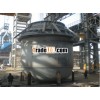The basic oxygen furnace (BOF), whose profile is shown in the figure, is a tiltable vessel lined with refractories such as magnesia carbon brick. Auxiliary equipment includes a chute for scrap charging, hoppers for alloys and fluxes, a lance for injecting pure oxygen gas, a sublance for measuring the temperature and carbon concentration of the molten steel, lifting devices for the lance and sublance, equipment for tilting the vessel, and equipment for recovering and cleaning the exhaust gas. The BOF capacity is expressed as the weight of crude steel that can be decarburized per heat. Most BOFs in China have a capacity of 150-300 tons.
The main function of the BOF is to decarburize the hot metal using pure oxygen gas. In the top-blown BOF, pure oxygen is injected as a high-velocity jet against the surface of the hot metal, allowing penetration of the impinging jet to some depth into the metal bath. Under these conditions, the oxygen reacts directly with carbon in the hot metal to produce carbon monoxide. The pure oxygen top-blown BOF can decarburize 200 tons of hot metal from 4.3% C to 0.04% C in about 20 minutes. As a result of this high productivity, the BOF replaced the open hearth furnace, which was a much slower process.
BOF furnace








